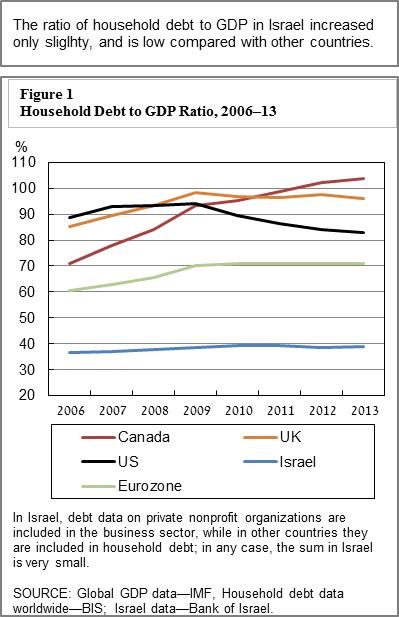![]() To view this press release as a Word document
To view this press release as a Word document
- In recent years, the rate of nominal increase in household sector debt has accelerated, primarily as a result of an increase in housing debt. Nonetheless, the ratio of household debt to nominal GDP increased only slightly, while the ratio to disposable income did not change, and is markedly lower than that figure in most advanced economies.
- The balance of assets and liabilities of households in Israel indicates that households, on average, have a large surplus of assets over liabilities, and their leverage is low compared with other advanced economies.
- In an analysis by income deciles, it can be seen that for households in the bottom three deciles, which are more exposed to the risk of recession and unemployment, the mortgage payment to income ratio is greater than the average.
Since the global financial crisis broke out in 2008, household debt in Israel has increased by 55 percent, and in March 2014 it reached NIS 412 billion. However, from the end of 2007, household debt as a share of GDP increased only slightly, and as a share of disposable income it did not change at all, due to an increase in GDP and disposable income, and it is markedly lower than the parallel ratio in most advanced economies (Figure 1). Most of the increase in the debt balance derived from credit for housing—debt for which the rate of increase has accelerated in recent years (Figure 2), and at the end of 2013 represents about 70 of the balance of household debt in Israel and about 30 percent of the banks’ credit portfolio. At the same time, in 2013, there was an increase of 7 percent in nonhousing credit from both banks and institutional investors. These developments expose the lending banks to risk from the household sector, should there be a sharp and rapid turnaround in the housing market, especially if together with the turnaround there is an increase in the interest rate or a recession and negative impact on borrowers’ income.
Recent years have seen expanded use worldwide of national balance sheets for analysis and assessment of financial stability. An analysis of various financial ratios from the asset and liability balance of households (such as the ratio of liabilities to total assets and to total financial assets, and the ratio of mortgage debt to real estate assets; see Table 1) indicates that households in Israel were more leveraged in 2012 than in 2006, but on average they have a large surplus of assets over liabilities and their leverage is low relative to other advanced economies.
However, since there is considerable income inequality in Israel, it is especially important to look at the average household in order to examine the stability of the household sector. To that end, there should also be an assessment by income deciles, in particular those which are exposed to a greater extent to the risks of recession and unemployment. One of the main indicators of borrowers’ repayment capacity is the payment to income ratio (PTI). If this ratio is examined by income decile, it can be seen that the PTI ratio[1] (the average of 2007–12) for the bottom three deciles is greater than the average (Figure 3). These deciles are more exposed to unemployment and thus the risk is greater that they will be unable to repay a mortgage.


